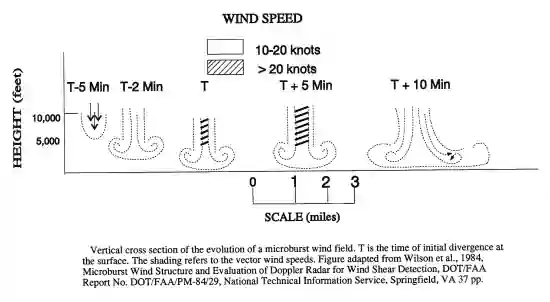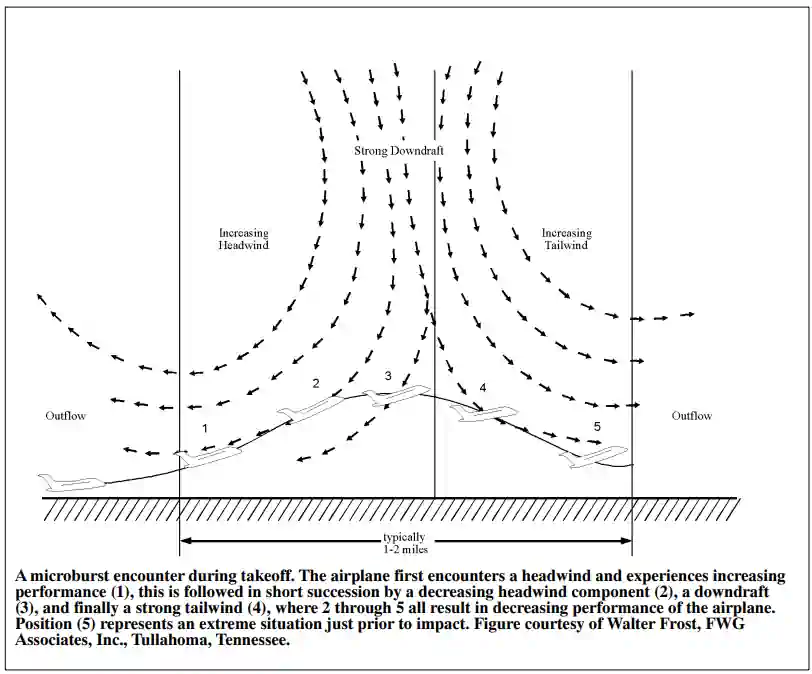Microbursts
Microbursts are small scale intense downdrafts which, on reaching the surface, spread outward in all directions from the downdraft center.
Introduction
Introduction
- Microbursts are small scale, intense local downdrafts which, on reaching the surface, spread outward in all directions from the downdraft center
- Microbursts are characterized by size, intensity, signs, and direction
- Parent clouds producing microburst activity can be any of the low or middle layer convective cloud types
- Microbursts commonly occur within the heavy rain portion of thunderstorms, and in much weaker, benign appearing convective cells that have little or no precipitation reaching the ground
- Usually found beneath thunderstorms and visible rain or virga
- Usually 1 to 2 miles in diameter; wind speeds can exceed 100 knots (10,000 Feet Per Minute (FPM)) and be accompanied by rain or other obscuring phenomena; usually lasts less than 10 minutes [Figure 1]
- Intense horizontal outflows at low altitudes result in extreme headwind to tailwind differentials that have been recorded in excess of 200 KIAS
- An important consideration for pilots is the fact that the microburst intensifies for about 5 minutes after it strikes the ground
- Experience has shown that microbursts are not isolated, but usually occur in groups
Microbursts Characteristics
Microbursts Characteristics
- Microbursts are small scale, intense local downdrafts which, on reaching the surface, spread outward in all directions from the downdraft center
- This causes the presence of both vertical and horizontal wind shears that can be extremely hazardous to all types and categories of aircraft, especially at low altitudes
- Microbursts may be either wet, referring to their presence from a thunderstorm, or dry, referring to their presence in clear air
- Due to their small size, short life span, and the fact that they can occur over areas without surface precipitation, microbursts are not easily detectable using conventional weather radar or wind shear alert systems
-
Size:
- The microburst downdraft is typically less than 1 mile in diameter as it descends from the cloud base to about 1,000-3,000' above the ground
- In the transition zone near the ground, the downdraft changes to a horizontal outflow that can extend to approximately 2 1/2 miles in diameter
- Microburst wind shear may create a severe hazard for aircraft within 1,000 feet of the ground, particularly during the approach to landing and landing and take-off phases [Figure 2]
- The aircraft may encounter a headwind (performance increasing) followed by a downdraft and tailwind (both performance decreasing), possibly resulting in terrain impact
-
Intensity:
- The downdrafts can be as strong as 6,000 FPM
- Horizontal winds near the surface can be as strong as 45 knots resulting in a 90 knot shear (headwind to tailwind change for a traversing aircraft) across the microburst
- These strong horizontal winds occur within a few hundred feet of the ground
-
Visual Signs:
- Microbursts can be found almost anywhere that there is convective activity
- They may be embedded in heavy rain associated with a thunderstorm or in light rain in benign appearing virga
- When there is little or no precipitation at the surface accompanying the microburst, a ring of blowing dust may be the only visual clue of its existence
-
Duration:
- An individual microburst will seldom last longer than 15 minutes from the time it strikes the ground until dissipation
- The horizontal winds continue to increase during the first 5 minutes with the maximum intensity winds lasting approximately 2-4 minutes
- Sometimes microbursts are concentrated into a line structure, and under these conditions, activity may continue for as long as an hour
- Once microburst activity starts, multiple microbursts in the same general area are not uncommon and should be expected
Indications of Microbursts
Indications of Microbursts
- Blowing dust, dust devils, and gust fronts (down bursts will occasionally generate distinctive circular dust patterns)
- Thunderstorms in vicinity with visible areas of intense downdrafts indicated by rain or virga
- Sudden and unexplained increase in airspeed as noted on airspeed indicator accompanied by increased AoA, indicative or rolling outflow
- Sudden increase in rate of descent accompanied by a lower AoA, indicative of entry into microburst core
- Extreme variations in wind velocity and direction in short time
- Significant differences between winds at 1,500' to 2,000' AGL and the surface winds
- Ground stations, radar, PIREPS and LLWAS help in identification
Recovery
Recovery
- If you find yourself caught in a microburst, immediately go around and execute a missed approach
- Report it to ATC as soon as possible
Microburst Case Studies
Microburst Case Studies
Conclusion
Conclusion
- For more information, a paper copy of Federal Aviation Administration (FAA-H-8083-28) Aviation Weather Handbook [Amazon] is available for purchase
- A digital copy of Federal Aviation Administration (FAA-H-8083-28) Aviation Weather Handbook is available from the FAA's website
- Improve your weather skills with FAA provided (and WINGS credited) resources by going to https://www.faasafety.gov/ and type "weather" into the search bar
- Still looking for something? Continue searching:
References
References

